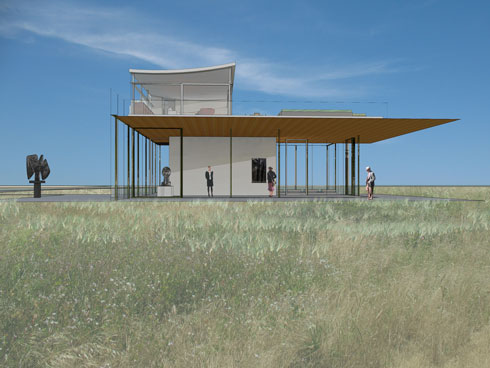The final Feasibility Study and Community Design Report is available here
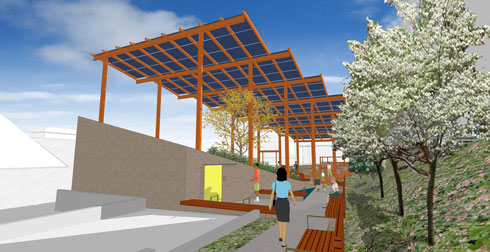
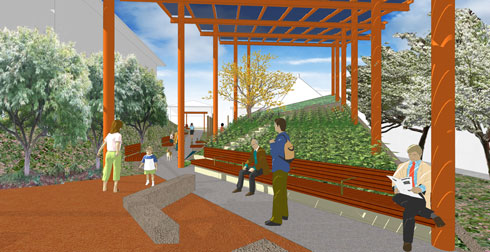
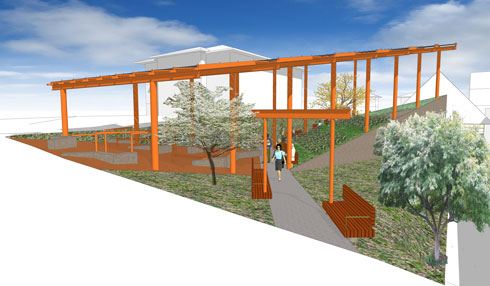
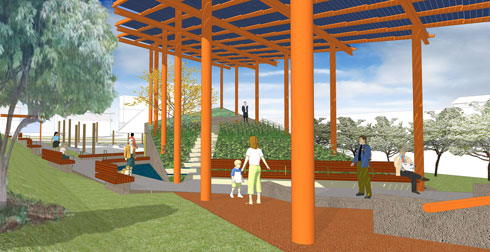
We're busy, and that is news in an of itself. Â Not that we haven't been keeping busy over the last year and half since the big crash, but given the abysmal state of the construction industry as a whole, we're happy to report that anecdotally there seems to be more activity out there (knock on wood). More housing starts, sales, news in the Daily Journal of Commerce about other firms hiring, and some of those holes in the ground out there starting to see renewed activity. So what have we been working on?
First, check out the latest schemes for the Sunset Substation pocket park in Ballard. Â We've made a hybrid scheme out of the three prior options, increased the potential of the solar array, and reworked the parkscape with a more sculptural land forms and a sinuous path from corner to corner:
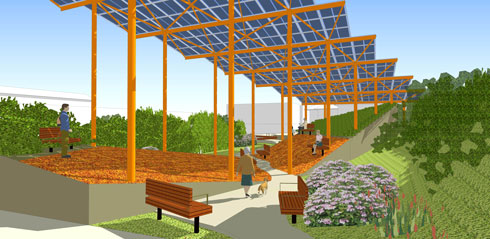
We've also been working on a great remodel/addition in Laurelhurst, opening up a classic midcentury modern house. There is a timber bamboo grove and small park to the north, creating an intimate feeling for the new kitchen and dining room despite the expanse of glass:
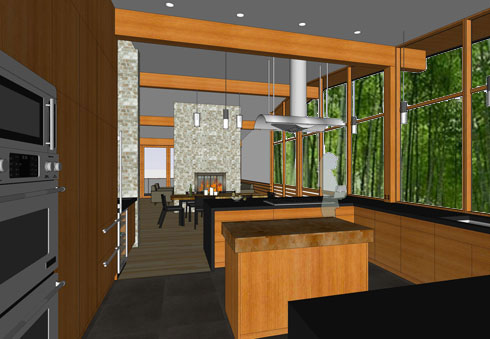
And we're making some progress on the Mitate House. I'm excited that as the design has been refined, we're getting more elegant volumes, a clean functional plan and expanding the opportunities for interaction with the landscape. Â I'll be posting more shortly on this one--we're getting the renderings ready for the builder's pre-sale marketing and will highlight the sustainable construction aspects:
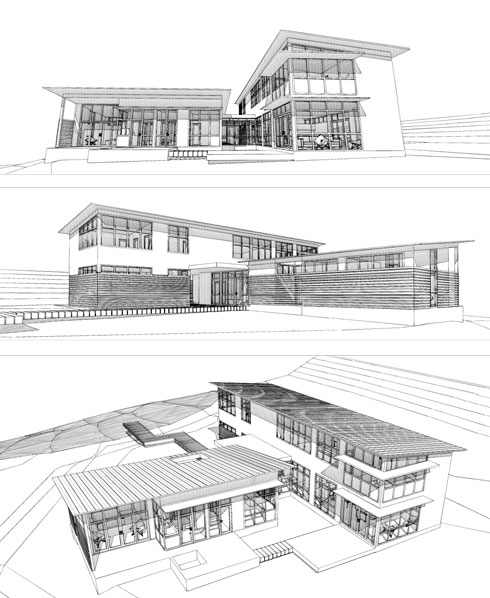
Plus we're working on a live/work in Fremont, renovations in Ballard, Sand Point, Montlake, Capital Hill, a restaurant, 2 backyard cottages, to name a few, and I'll feature some more projects this month.
We've done our first presentation of three ideas for the Sunset Substation Park. Â More information about the three schemes are here, here, and here.
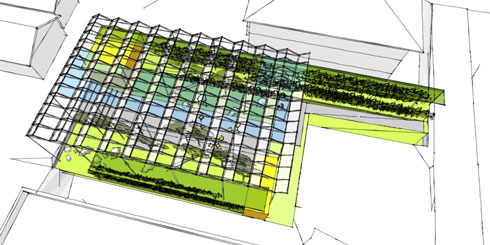
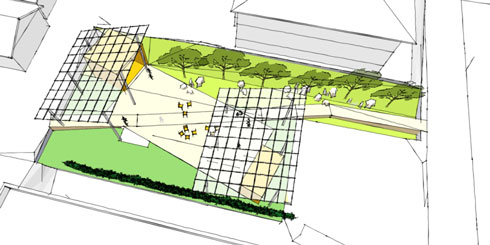
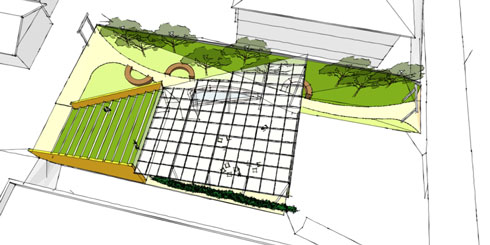
The solar component of this park will produce between 20 kW and 30kW, and provide power for the community multipurpose space, and an emergency relief center.
We're looking at meeting the Living Building Challenge, the highest standard for sustainable construction. Â It would be a major undertaking, since there are less than a hundred structures in the world currently attempting to meet this challenge, but we have a lot of things going for us at this scale of project. Â As the project develops, I'll keeping posting information on the Challenge--how it is affecting the design, and the costs.
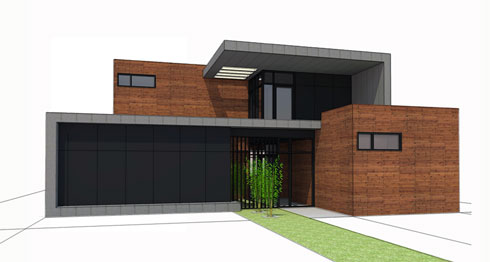 We've completed the first community design workshop for the Sunset Substation pocket park and we've started a blog for the project at www.SunsetSubstation.org. Â The results of the workshop are posted here and you can read a write up from the Ballard News tribune here and another article from KOMO's neighborhood blog here. Now that we have some community input, we can start shaping their unique goals for bringing solar power generation and community space together.
We've completed the first community design workshop for the Sunset Substation pocket park and we've started a blog for the project at www.SunsetSubstation.org. Â The results of the workshop are posted here and you can read a write up from the Ballard News tribune here and another article from KOMO's neighborhood blog here. Now that we have some community input, we can start shaping their unique goals for bringing solar power generation and community space together.
In other news, Stefan is working through designing a micro-hydroelectric generation station for an eco-retreat/outdoor recreation center and meditation retreat in Colorado, and should be posting an introduction to the project and more information about micro-hydro. Â Suddenly, we have a lot of projects which have some active or passive alternative energy components--very exciting stuff.
Tim is leading the charge on backyard cottages. Â We have two custom cottages currently in design, and another design which will be available as a prefab. Â We're finalizing the pricing, so we will have a more comprehensive information available soon.
We're also working with a homebuilder  to develop a series of spec homes bases on a fusion of asian design, modern spaces and out of the norm materials (see image above).  We're especially excited because the house's function emphasizes a series of landscapes integrated into living spaces, so we'll have courtyards, pocket gardens, and salad gardens for growing your own vegetables off the kitchen.  Our big presentation is on Tuesday so I'll post the schematic renderings afterwards.
Finally, this is the last weekend to see our WASTE NOT installation in the alley east of First Avenue, south of Occidental Park. Â Anyone need 2500 2 liter bottles?
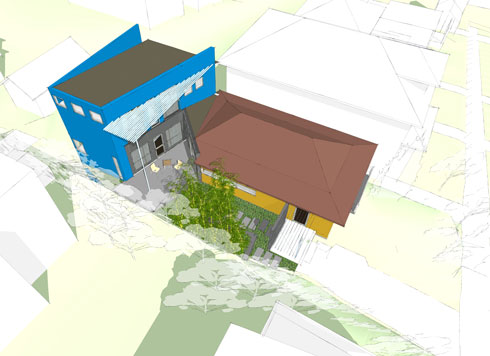 Here's another new project in the office, an addition to a residence on Capital Hill. The existing house is a tiny 750 sq. ft. bungalow on one of Seattle's steepest streets. The owners found the compact plan a perfect fit when they first moved in, but two kids later, they desperately need more room. They are drawn of the core values of modern architecture: emphasis on natural light, spaces that flow together, honest and straightforward materials and want a house that expresses that. They are comfortable making a pretty bold statement, but they also want the addition to feel comfortable in the existing fabric of the neighborhood. They are interested in sustainability that is designed in from the ground up, which led to the early decision to preserve the existing structure instead of starting from scratch on the site.
Here's another new project in the office, an addition to a residence on Capital Hill. The existing house is a tiny 750 sq. ft. bungalow on one of Seattle's steepest streets. The owners found the compact plan a perfect fit when they first moved in, but two kids later, they desperately need more room. They are drawn of the core values of modern architecture: emphasis on natural light, spaces that flow together, honest and straightforward materials and want a house that expresses that. They are comfortable making a pretty bold statement, but they also want the addition to feel comfortable in the existing fabric of the neighborhood. They are interested in sustainability that is designed in from the ground up, which led to the early decision to preserve the existing structure instead of starting from scratch on the site.
How to add onto an existing building that has a well-defined or historical style is a perennial architectural puzzle (and hip roofs are especially difficult to achieve seamless integration). In this case, we approached it by creating a clear contrast between the new and the old through form, material and color. But it's not enough to just plunk a contemporary form next to an old house and expect a real conversation to take place. In this addition, the new and old talk to each other both in how the volumes intersect and in how the two differing styles overlap.
Intersection Our early drawings all show a long, narrow addition running north-south to hold the downhill edge of the property. However, after looking at dozens of alternative schemes, we realized the potential for a very special outdoor space, between the south-facing wall of the addition, the steep hillside and the existing house. Private, yet with almost ideal sun exposure, this patio is the heart of the design but it sets up a tricky problem: we wanted to the public and private wings of the house to fit up against one another while at the same time creating a space between them.

In the rendering above, you can see how we resolved this conundrum: the charcoal-colored wall literally acts like a giant door, swinging out of the (blue) addition to carve space from the (yellow) existing house and define the courtyard. This dividing wall gets a different material and different detailing show a clear relationship between the planning and the way the house is actually made. Creating a courtyard at the joint between the new and old helps to differentiate the two volumes and separate the bedrooms from the public spaces. The slight angle of the addition's south wall also provides enough solar exposure so that a concrete trombe wall behind the south-facing glass is effective in reducing the use of conventional heating by about a third. (More on the passive solar design of this house in a later post)
Overlap While they are separated by their overall form, the old and new portions of the house are tied together by elements that extend the language of one style into the other portion of the house. The largest example of this is the secondary level of detailing we are developing for both structures. The large-scale metal sun canopy of the addition is repeated at a smaller scale as a canopy at the front entry and then inside the original house as a pair of room-divider screens that create separate zones within the loft-like space (and incidentally help act as shear walls).


The language of filtering light through parallel vertical columns even extends the site design: the wide sideyard on the west creates the perfect bamboo garden outside the kitchen's horizontal slot window and a verdant path to the courtyard.

We are very excited to begin a new project for the Sunset Hill neighborhood to transform an abandoned City Light substation parcel into a pocket park.  Based on the input from the community thus far, the program is very intriguing:  a community space with an artist-in-residence caretaker, powered by a serious photovoltaic array. There may be more or different elements as the project evolves in the community design process, and as we navigate through various City agencies and funding sources, but fundamentally this has all the values we expound as a firm:  sustainable building, energized public space, housing options/density, and  an interactive process that invests people in the civic life of their neighborhood.
In 2008, I designed a structure with a similar program for a Dwell Magazine conceptual competition:
Set at the east end of Crissy Field in San Francisco, this Community Room/Exhibit Hall creates an anchor for a new sculpture park. The hall is a multipurpose space, more infrastructure than building--for public events, private events, exhibits, etc. The glass sliding panels open the hall to the public, the park and the views of the Golden Gate Bridge.
A small caretaker's residence is situated on the second floor, using the broad roof of the Community Room as a vegetable garden, eliminating the conflict between the public park and the private residence. The glass screen walls provides security, and electricity--the design on the glass is created with a photovoltaic interlayer, which powers the house and hall. Stormwater is captured, stored and used to irrigate the roof garden.
While this little conceptual project may help to inform the Sunset Substation, I'm excited to apply some of this experience in designing a real world pocket park.
Stay tuned....
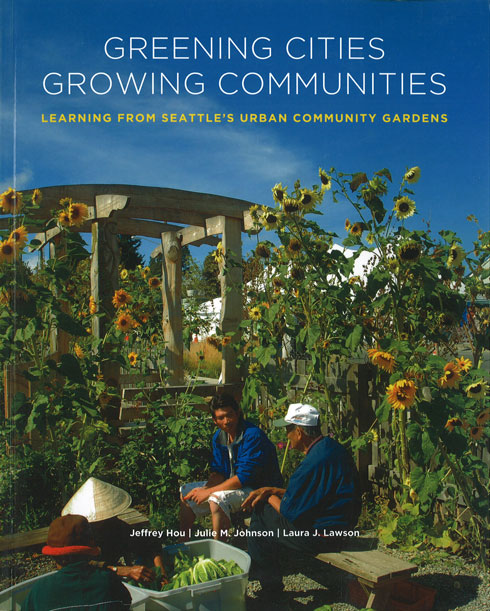 We are very excited to see this survey of Seattle's urban community gardens, especially since the Interbay P-Patch is included as one of the case studies. Â The P-Patch is one of my personal favorites because of the impact it has had in strengthening this vital community, and has been instrumental in showing other neighborhoods how to implement their own community garden.
We are very excited to see this survey of Seattle's urban community gardens, especially since the Interbay P-Patch is included as one of the case studies. Â The P-Patch is one of my personal favorites because of the impact it has had in strengthening this vital community, and has been instrumental in showing other neighborhoods how to implement their own community garden.
Further, the P-Patch really showed us just how satisfying working on these small pro bono projects can be. Since the P-Patch, we'll donated about 5% of our yearly output to pro bono causes, including daycares, parks, and community centers and hope that we'll have more opportunities to help concerned citizen groups visualize and build a better city.
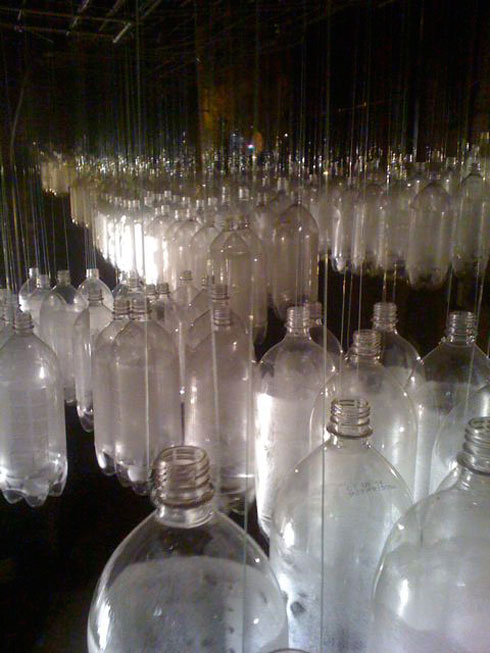 Our installation just got linked on the Stranger's SLOG.
Our installation just got linked on the Stranger's SLOG.
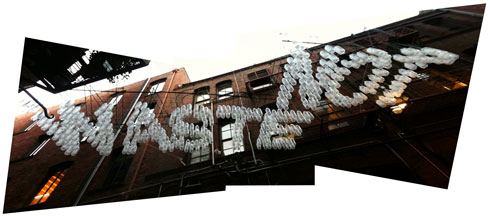 The big opening is tonight from 5 to 9, between 1st and 2nd just south of Pioneer Square--
The big opening is tonight from 5 to 9, between 1st and 2nd just south of Pioneer Square--
Yesterday we hoisted the installation in place. While we still have to do lighting, the impact is great! From the end of the alley, the installation looks like a lonely cloud hovering there, and only once you get beneath it can you see the message "WASTE NOT."
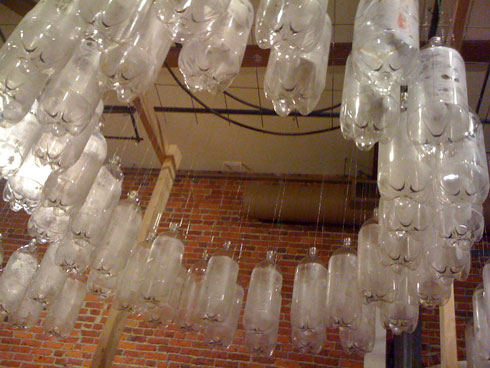 We are working on a collaborative art installation for the Nord Building's upcoming Alley Party, sponsored by two non-profits, Feet First and the International Sustainability Institute.
We are working on a collaborative art installation for the Nord Building's upcoming Alley Party, sponsored by two non-profits, Feet First and the International Sustainability Institute.
Feet First is an advocate for walkable communities, and ISI works on documenting global best practices for urban sustainability. Â They have been working with their neighbors to transform alleys from nuisances to assets. Part of the program to invigorate the alleys as a vibrant urban places is their Alley Parties. Â Each one incorporates art, music, food and drink to draw people into the alley and give people a different perspective on what they can become.
This Thursday, CAST, in collaboration with Christopher Ezzell of E Workshop, and Vashon Island artist Shahreyar Ataie,  will open an art installation that will float over their the Nord Building's section of alley, using about 600 recycled 2 liter bottles.  It will be up through the New Year.
So come one and all! Â Did I mention there will be food, drink and music?
Alley between 1st and Second, just South of Occidential Park
314 First Avenue
November 3rd, Â from 5 pm to 9 pm

